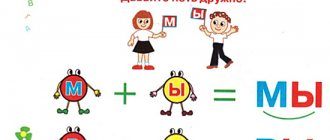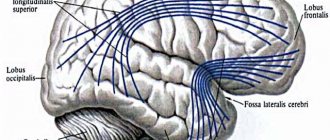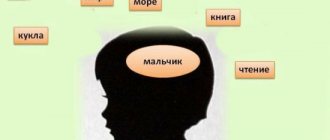What children need to know about emotions
By the senior preschool age, the child has already formed an idea of human emotions, which include:
- joy
- sadness
- fear
- anger
- resentment
- astonishment
Children define and name psychological states, briefly describe them, and give examples of everyday situations in which a person experiences them.
Pictures for children depicting emotions teach the child to reason, describe cause-and-effect relationships, and analyze his own life experience.
During speech therapy work, it is useful to offer preschool children topics related to people’s experiences to compose narrative stories. For example:
- Is it only humans who have feelings?
- What are positive and negative emotions?
- When am I happy and when am I sad?
Emotions can be divided into pairs with opposite meanings. For example: joy - sadness, disgust - admiration, boredom - interest, etc. Children should be able to recognize and name the feeling of the character in the picture, but also select antonyms for the definition. Exercises in this format allow you to more firmly consolidate the characteristics of emotions.
Children should know that we can learn about a person’s psychological state both from words and by observing actions and behavior. Each emotion has a corresponding dictionary and a set:
- gestures
- facial expressions,
- actions
It is useful to have conversations with older preschoolers about how their emotional state needs to be managed, especially when it comes to negative feelings. You cannot give free rein to anger, irritation, or sadness. Express feelings only in socially acceptable ways. Children will be interested to know that in countries around the world people express feelings in different ways.
What is PECS
The main problem of children with special needs is that they cannot speak and express their needs.
If parents can still somehow understand what their child wants, then when communicating with strangers, children with autism spectrum disorder have difficulties - they are often not understood, as a result of which the child begins to get nervous, freak out, show aggression, etc. The question arises: how to communicate with a nonverbal child? Article on the topic: Basic rules for teaching an autistic child
Such children need special teaching materials, without unnecessary details - cards and visual schedules, with the help of which the child can communicate with other people.
PECS is an alternative communication system using card exchange, which was originally created for children with ASD. But as it turns out, this system is suitable for absolutely all children who have difficulties with speech and communication.
These materials will help achieve success in the development of non-verbal children (autism, hearing loss, mental retardation, cerebral palsy, etc.), and often become a necessary means of communication in their adult lives.
Defining emotions for children
For speech therapy work with students in the senior and preparatory groups of kindergarten, use the following list of emotional states:
Joy is a positive emotion familiar to everyone. We feel joy when something good happens. A person can express this feeling through words and actions. Signs of a joyful state are laughter and smiling. Experiencing joy feels good, as does bringing it to others.
Sadness is a feeling that appears when we learn or think about something sad. Sadness cannot be called a strong emotion; it passes quickly. This does not mean that you should not allow yourself to be sad; sometimes every person needs it. But you shouldn’t indulge too much in a sad mood; it’s more useful to try to quickly get rid of it by doing something pleasant or useful.
Anger is anger, strong irritation towards someone or something. Feeling angry is not pleasant, but sometimes it happens to everyone. It is a strong emotion that can cause trouble for us and others. It is important to explain to children how to manage anger and be able to express it correctly. If a person is often angry, then it is difficult for him to find friends, he is often lonely.
Fear is a strong negative emotion that people experience if they are threatened by something. The danger can be real or expected or imaginary. Every child has repeatedly felt fear, so he can easily recognize its image in illustrations or photographs, and also give examples of events, objects and phenomena that cause this feeling in them. Children should know that fear varies in intensity, from fear to horror. It is important to explain to children that this emotion is necessary for a person, as it warns of danger. It can be added that the color black is often used to illustrate fear in pictures.
Admiration is a pleasant emotion that arises when encountering something very beautiful or unusual. Admiration can be caused by: an unusual toy, a garden in bloom, an elegant girl. People, expressing admiration, use special exclamations: (oh, ah, wow, wow) and words (really, amazing, wonderful, wonderful, extraordinary). Admiration can be so strong that it is very difficult to express your feeling in words. From a photograph or drawing, preschool children can easily recognize a person who admires something, although it is difficult for them to describe his feelings; this requires special speech therapy training.
Shame is an unpleasant feeling that occurs when we have done something bad and regret it. The older the children, the easier it is to explain to them the essence and meaning of this emotional state. Signs of shame are not only certain facial expressions, but also redness of certain parts of the face (cheeks, ears, neck). Knowing this feature will help preschoolers quickly and easily recognize shame in drawings (by the way, this sign can often be seen in story pictures for children and even in selfies) and in the behavior of people around them. You can have a conversation with children 6-7 years old about the difference between shame and shyness; these states are easy to confuse.
Resentment - a person feels resentment when someone’s action seems unfair to him. Some people are touchy, others rarely experience this emotion. It is difficult to describe the state of resentment; preschool children should be able to recognize its image. To do this, you can use both schematic images (for example, emoticons - simple pictures of emotions for children), and realistic drawings, color or black and white photographs. By the way, it is convenient to print such visual material from collections and presentations on specialized speech therapy websites.
How to make PECS cards yourself
PECS cards are very easy to make yourself. It is best to use photographs, because... The image is more realistic and is better perceived by the child.
You can also print pictures found on the Internet on a color printer. It is easy to make pictures of the required size by saving them in a pre-created table in Microsoft Word.
After printing, it is better to laminate or seal the cards with tape. On the back side, glue Velcro with adhesive backing, which are sold in a sewing store.
Article on the topic: Game sets for children with autism
Drawn pictures
Emotions in pictures for children, used for classes on speech development, are presented in several versions: images of adults and children, people or fairy-tale characters. Printed pictures and drawings created by children are suitable for the development of speech in preschoolers.
Invite the children to draw themselves or another person experiencing a certain feeling. Drawing up a verbal explanation for such a picture is a speech therapy exercise that the children do willingly.
If children are not yet able to cope with independent depictions of emotional states, it is worth inviting them to create a collage from pre-prepared and printed facial details. Preschoolers aged 6-7 years are able to recreate emotions on paper on their own, but for younger children it is worth using ready-made templates and samples.
In speech therapy work, you can use not only drawing, but also coloring. Thematic coloring books are a useful and exciting material that is indispensable for girls and boys in kindergarten and at home.
It is important to first thoroughly study with children not only the names of different emotions, but also those artistic techniques that allow you to accurately convey one or another psychological state of a person. The use of pictograms can be very helpful in this regard.
Description of the test Pictogram according to the A.R. method Luria
Alexander Romanovich Luria is a follower of Lev Semenovich Vygotsky, one of the founders of Russian neuropsychology. The Pictogram test, developed by him as part of the development of this area of science, allows us to identify the features of memorization through associative connections. The objectives of the study are:
- identifying the nuances of indirect memorization;
- assessment of memory productivity;
- determining the nature of mental activity;
- studying the level of development of imaginative thinking.
The technique is not used for diagnosing preschoolers and primary schoolchildren, but is only suitable for testing among subjects with at least 67 years of education.
Pictograms
Schematic representations of various emotions greatly help children in learning, remembering and recognizing human emotional states. Especially in the early stages of getting to know this topic. Various sets of “Emotions emoticons pictures for children” contain cards with a conventional image of anger, joy and other feelings.
How many PECS cards should I start with?
A child, of course, will not immediately have a whole album of PECS cards. You should start with one motivational or two yes/no cards. If the child understands everything and is quick to learn, another card is added - and gradually their volume is increased to the required size.
You can make PECS cards on the topics: “a trip to grandma’s, “watching cartoons,” “brushing your teeth,” “daily schedules,” “need cards,” etc.
All activity cards must be available so that the child can use them at any time.
Games with pictograms
Games with pictograms are a whole area in the work of speech therapists and psychologists. Schematic images of emotions (faces) are excellent material for stimulating a child’s speech activity. Here are some examples of using such images:
Pick and name
Prepare pictures of pictograms with different emotions and feelings for children. The task is to find out this or that state, give it a name, and then come up with a situation in which it would be appropriate. Children can use both their personal experience and remember the heroes of famous fairy tales and cartoons. It’s okay if at first the descriptions of emotions sound childish, gradually regular speech training will help these stories become more perfect.
Find a match
If you take a cut set of emoticon pictures and mix them up, you will get an exciting game for a team of preschoolers, which can also be used in speech development classes. The task is to collect all the images. It is important that each emoticon accurately expresses a particular feeling, then the emotion will be easier to recognize and describe.
Transformations of moods
For this game you need to select the following emoticons, pictures of emotions for children, which can be sorted into opposite pairs. For example, sadness-joy, admiration-disgust, etc. Ask the children to take one card or a round smiley face, and then match the selected picture with a pair. After this, you can invite the children to come up with a story about what could turn one emotion into another.
Koloboks
The image of a kolobok is similar to a smiley face, so also use pictures with this character as pictograms illustrating emotions.
Use Kolobok’s drawings on a transparent background, so it’s easier for children to analyze the psychological state of the hero, and not the plot twists that happen to him.
There are many options for games with this fairy-tale character. For example, tell a Russian fairy tale, describing the emotions of Kolobok and other characters. The use of puppet theater or masks will help make this activity productive.
Emotions in the country of Smeshariya
Toys from the cartoon Smeshariki - material for classes on speech development in preschool educational institutions and at home. Images of funny round characters can be used to illustrate emotional states. Buy a ready-made manual or make it yourself, cutting out and signing characters from a magazine or book.
Offer the children pictures of Smeshariki and ask them to name the feeling that Nyusha, Kar-Karych, Krosh and other characters experience.
Working with PECS cards
Work with cards should be started with a speech pathologist or other correctional teacher, who, by observing the child, will determine his skills and abilities.
At the first stage , as a rule, teachers advise entering two PECS cards first - “no” and “yes”, because Children with ASD often struggle to copy and repeat movements such as nodding and negative head movements.
Mastering these two cards will make life much easier for parents and children.
Important! If the child can say the words “no” and “yes” or make a gesture, there is no need to use cards.
The second stage of entering PECS cards is the child's motivational items and activities.
For example: a picture with candy. You need to show the child this picture and ask: “Do you want it?” If yes, then organize an exchange and say the name of the card. During the transfer of candy, the card should be taken away and be sure to be praised. Next, the child should be familiarized with other designations of motivational objects.
The actions indicated by the picture are entered in the same way as objects.
For example: the baby loves to ride on the swing. You need to show a suitable picture, say “ride”, give the child a ride and show the picture again.
Important! As soon as the child tries to name the desired object with a word, the card should be removed from the album.
The third stage of PECS training will be a set of cards that accurately represent events - a schedule.
The schedule includes several cards of a certain topic, located one after another in a certain order.
This could be a schedule for the day, going to the store, cleaning, getting ready for the store, eating, etc.
This stage is introduced on the condition that the child sees and understands the pictures on the cards and correlates the pictures with their meaning.
Example: “day schedule”. To enter these cards, you need to prepare a tablet (cardboard or plastic base), on which pictures or photos will be lined up depicting those everyday activities that the child needs to do during the day.
The cards should be distributed in such a way that the program activities are located immediately before the child’s favorite activities, such as watching cartoons, going for a walk, etc. This way, the child will understand that he needs to study before going for a walk.
The schedule can be used for child development for educational purposes. Taking an album or tablet, you need to ask: “What do we have now? What's next? " At the end of the day, when all the events from the daily schedule are over, you need to collect the cards and talk with the child: “What happened at the beginning of the day?”, “What happened after class?”, “What did you do after watching the cartoon?” etc.
A schedule is needed not only for learning, but also to remove the child’s feeling of anxiety. It is often found that children with ASD experience anxiety if their usual daily routine is disrupted and the child does not understand what will happen next.
For example, an incident from the life of a family: when the family was getting ready to go somewhere in the car, the girl with autism began to be capricious and cry. She thought that they would now take her to the doctor, because... This happened once, and children with ASD tend to remember negative incidents. In fact, the family was going to go to the store or to the park. That is, if the girl knew that when she got into the car she would go for a walk, and not to the doctor, she certainly would not cry.
Article on the topic: 6 questions about the independence of a child with autism
Processing and interpretation of results
If the subject draws little people as illustrations of all concepts, then this indicates his sociability
The content of the drawings reflects the subject’s stock of knowledge, as well as some features of his life experience and ability to abstract. Pictograms are classified into 5 types:
- A - abstract (the drawn lines are not formed into a separate image);
- Z - iconic or symbolic (images are arrows, squares, trapezoids, and so on);
- K - specific (very specific objects are presented);
- C - plot (drawn pictures are united by a specific situation);
- M - metaphorical (the drawings are the artistic creation of the subject; for example, for the concept of “joy” a jumping person is depicted).
The experimenter notes the type of each pattern and then counts the frequency of use of each type:
- If abstract and symbolic images predominate (more than 55%), then the person can be classified as a group of “thinkers” who are aimed at synthesizing the information received and generalizing. Such people have a high degree of development of abstract logical thinking.
- With frequent plot and metaphorical drawings, one can conclude that the student is creatively thinking. Such subjects are called “artists.” This result is typical mainly for children 12–14 years old.
- When images are mostly represented by certain objects of the surrounding world, this indicates the predominance of a concrete and effective way of thinking. Such people strive to approach all issues from a rational point of view. They are called "practitioners". But usually such results are observed only in adults (most often in teachers and executives).
You can make a conclusion about the level of development of the conceptual apparatus by how freely the test subject reproduces words from images in the final test.
Another additional parameter that can be determined is sociability. If the subject draws little people and remembers the words without hesitation, then he probably likes to be surrounded by people. But when it is difficult for a child to navigate by drawings of people, this indicates the immaturity of the person being tested.
The author of the technique, in addition to diagnosing the quality of memorization, also proposed assessing the exhaustion of attention. To do this, it is necessary to analyze the firmness of the pressure, as well as the increasing negligence in performing the task. The more pronounced the changes in these characteristics, the higher the exhaustion.
Assessment of qualitative indicators of thinking is carried out according to 4 criteria:
- Adequacy. To understand this property, just look at 1-2 pictures. Sometimes you need to pay attention to the author’s commentary. If a logical and substantiated connection between the concept and the image is noticeable, then the experimenter marks the pictogram with a “+” sign; if there is none, “-”. More than 70% positive marks are considered normal.
- The ability to restore images after a certain amount of time. The number of correctly named words in the final test is assessed. The norm is more than 80% of words and phrases.
- Correspondence of the pictogram to the real object. Concrete drawings are scored 1 point, abstract drawings - 3 points. If the image is difficult to classify, then 2 points are counted. Then the average is determined. The norm is more than 2 points.
- Originality. If the plot of the drawings of several test subjects matches, the image is scored 1 point, which indicates a mediocrity of the approach to completing the task. If the pictogram is unique, then 3 points are given for it. An intermediate option deserves 2 points. The norm, as in the previous case, is a result of 2 points.
The Luria pictogram allows you to evaluate not only the quality and speed of memorizing information, but also to get an idea of the ability to build associative connections between a concept and its image and such an important indicator of attention as exhaustion. Thus, in a short period of time, the experimenter receives a complete picture of the development of the basic properties of the test person’s thinking.
Categories by age
Action pictures like these require adults to adapt questions to the age of the children.
- 1-2 years - encourage the child to look at illustrations, find, name, show objects;
- 2-4 years – learn to compose sentences using different parts of speech. Describe the entire plot in short answers;
- 4-5 years – detailed description of individual objects, character behavior, processes. Repeating images created by an adult, as well as inventing your own continuation of the plot;
- 5-6 years - drawing up a plan for future children's stories.
Classes are conducted with subgroups of children or individually. The same image can be used first for learning purposes, and then (next lesson) to reinforce the material.
Action pictures for children
Pictures depicting actions will help teachers and parents organize their children’s education correctly and at the same time in an interesting way.
Colorful drawings stimulate the child’s memory and imagination. They will invariably attract and concentrate children's attention. They will direct the learning process in the right direction.
The purpose of such activities may be:
- identifying the level of the child’s vocabulary and increasing it;
- development of coherent speech;
- constructing correct simple/complex sentences;
- teach your child to select and correctly use different parts of speech;
- compose questions yourself and specifically answer those asked by your interlocutor;
- stimulation of memory, fantasy;
- development of logical thinking;
- training of observation, taking out;
- activation of imagination;
- acquiring new social experience.
Not only pictures depicting actions, but also illustrations of objects (furniture, dishes, vegetables and fruits), plot drawings are indispensable assistants in the learning process of preschoolers.





